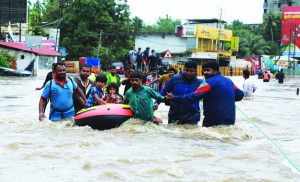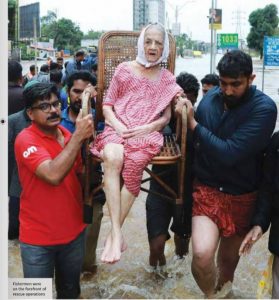
Upwards of 450 is the number of people killed by nature’s fury in Kerala and Karnataka as the worst ever floods in the century hit the two Southern states. More so, the God’s Own Country, Kerala, is slowly picking up the pieces after it went through the worst floods after 1924.
What is more tragic is that though the country by and large stood with Kerala and Karnataka in offering relief and mounting rescue operations, some people made insensitive remarks designed to communalise the tragedy and vitiate the atmosphere. Luckily, such was the reaction from the people at large that these attempts failed to make much headway in their campaign.
But at another level the response of the central government evoked sharp reactions from the ruling dispensation in Kerala as also in Karnataka, both ruled by non-BJP entities.
For the lakhs of flood victims in both the states, this certainly is not the time to analyse the cause of the floods. Rather it is time for rebuilding the state, which at a rough estimate would cost upwards of 20,000 crore. But against a preliminary demand for an assistance of this amount, the central government announced 600 crore, which would take its own time in coming — as a loan, prompting the Left and Congress to launch a diatribe against the Modi government for playing partisan politics.
Besides, citing an old UPA government decision, the central government also refused to take a 700 crore relief announced by the UAE, which has blown into a major controversy, saying India was quite capable of taking care of its own and did not prefer taking foreign help in disaster management during natural calamities.
“In line with the existing policy, the government is committed to meeting the requirements for relief and rehabilitation through domestic efforts,” the Ministry of External Affairs spokesperson said.
It was understood that by ‘existing policy’, the MEA was indicating at the decision taken in 2004 to avoid foreign support in the context of the deadly tsunami that affected a large number of countries in the Indian Ocean region.
Former diplomats have flayed the government decision, saying that it should have been more considerate on the proposed support from the Gulf.
“As country we can give rather than take assistance, but 80% Indians in the Gulf are Malayalis. The offer of flood relief assistance from region must be treated with sensitivity. Saying no is simple, but for Kerala-in-crisis, it’s not so simple,” former Foreign Secretary Nirupama Rao was quoted as saying in the media.
Former Foreign Secretary and National Security Adviser Shiv Shankar Menon said: “…. the 2004 decision was not to accept foreign participation in relief but accept it for long-term rehabilitation case by case.” He said the UAE help could have been utilised for “rebuilding houses, bridges, roads etc.”
Former foreign secretary Kanwal Sibal said this issue should be thrashed out internally to avoid any long-term fallout.
Rebuilding damaged roads and bridges in the unprecedented deluge in Kerala will take at least one and half years and cost close to 6000 crore.
The Kerala government has sanctioned 1,000 crore for emergency maintenance works and has to raise 5,000 crore for ongoing development projects.
The PWD suffered the maximum financial loss in the calamity and is seeking 4,978.08 crore for the reconstruction of roads, from small ones to state highways. The repair of national highways would need 533.78 crore. Bridges wrecked in the flooding would require 293.3 crore and government buildings 10.09 crore.
The damage to roads is of up to 34,732 km and 218 bridges were damaged.
Irrigation facilities, standing crops and plantations losses are estimated at 20,000 crore, farm experts said. But a final assessment can only be made after situation returns to normal. For the present, close to ten lakh people have been housed in temporary structures. Slowly as water begins to recede the state government is also pitching in with cleaning the houses and colonies that were flooded. The government has set up a control room in the state capital to cordinate the cleaning process. At the last count, the government teams cleaned one third of the over 15 lakh houses that needed immediate attention. At least, 50,000 volunteers are on the job, aided by the government agencies and donor.
Though the damage is instant, central government assistance will take some time reaching Kerala due to procedural issues. The centre has though promised to speed up things, the process of assessing the extent of damage and fund release was time-consuming.
The Centre has so far released 600 crore for Kerala as immediate relief.
When politicians on either side of divide concentrated on the politicisation of human misery, it is the common man, individually and in groups who came to the rescue of people marooned in their own homes, that flood waters submerged and made difficult to access. The natural disaster was also a leveller of sorts that the floods hit people from every class of the society equally.
But helping Kerala stand back on it’s feet were good Samaritans who sprung up from all across India, other than the defence forces, paramilitary forces and coast guard services personnel who were pressed into service.

Kerala rains 2018 is something that not many residents of Kerala will forget in their lives. In fact, outflow from reservoirs in Kerala began days before the flooding started, but this release of water did not help prevent flooding. Mainly due to the intensity
of rains.
According to IMD, Kerala received 39% more rainfall than normal during the South West Monsoon.
Classified as “Excess”, the state got 302.7mm actual average rainfall, which is more than thrice the normal rainfall average between August 16 and August 22.
Three years ago in December 2015, Chennai received its largest rainfall in a century to flood the city and neighbouring districts that left a trail of destruction.
If Chennai was a trailer, Kerala and Kodagu (Coorg) in Karnataka, are warning signals to the rest of the country that Mother Nature was angry — angry over wanton destruction of nature due to human greed, and could strike at will anywhere in the country. Experts believe this flooding as a cause of climate change induced by destruction of environment and ecology.
For sure, this is a self-made natural disaster that the mankind has inflicted upon itself and Indians have done it more efficiently — the destruction of nature without any regard for the environment. And will have to pay the price.
Kerala and Kodagu floods were predicted a few years ago, but the warnings were thoroughly ignored by the authorities, under political dispensations of different colours.
Experts predict that next in line would be Goa that is also afflicted with all the ills that environmentalists have been complaining about.
In 2011, the Western Ghats Ecology Expert Panel, chaired by the internationally renowned ecologist Madhav Gadgil, had warned an ill-thought focus on development was impacting the sustainability of the Western Ghats hill chain, one of the world’s most biodiverse areas that run along the west coast of India.
He urged both Karnataka and Kerala, among others, to adopt a more thoughtful approach to conservation, limiting activities such as quarrying, dams, and construction near protected forests in hilly areas. This report was rejected by central as well as state governments.
In 2015, the Karnataka government had cut down thousands of trees to erect High-tension electric wires through Kodagu. Then there is uncontrolled sand mining in river beds, all across India, rapid urbanisation that were leading to flash floods and landslides during heavy rains. Multi-storey buildings were leading to weakening of soil too.
In Kerala, flooding of Kochi airport is a shining example of poor planning that caused a disaster. Built on the paddy fields and wetlands next to Periyar river, it runs up to the banks of the river on one side.
When a number of dams on the river had to be opened due to heavy showers, the airport was submerged and all operations had to be stopped. The estimated loss of at least 500 crore due to closure.
Kerala has 44 rivers and built 61 dams over them. Many of these dams had to be opened to release excess water that led to heavy flooding.
Never were these dams inspected for pre and post-monsoon safety
The Periyar river is not the only one that has been dammed. The state of Kerala has 44 rivers with a total of 61 dams. Many had to be opened across Kerala as they were dangerously full — a step that, while essential during a time of emergency, contributed to the heavy flooding. None of these dams were subjected to pre and post-monsoon inspections.
Kochi is just one example, even Mumbai airport too is susceptible to flooding and Chennai airport too was flooded.
In Kerala, the cumulative rainfall of 2,378 mm over 88 days, four times more than normal was the most intense than the flood of 1924. The reason why Kerala got so battered was that its capacity to deal with such calamities was reduced due to illegal stone quarrying, cutting down forests and grasslands, changing drainage patterns and sand mining on river beds.
“Rampant stone quarrying and digging of pits is the reason behind the landslides and landslips, which worsened the situation in the Kerala floods,” Madhav Gadgil, ecologist and founder of the Centre for Ecological Sciences at the Indian Institute of Science, Bengaluru, was quoted in the media. “These quarries cause deforestation and block the natural streams, which help in reducing the intensity of the floods.”
Most of the 373 casualties in Kerala were caused by landslides in the northern districts of Malappuram and Wayanad, and the central district of Idukki.
Spread across 160,000 square kilometres, more than three times the size of Haryana state, the Western Ghats extend over six states — Kerala, Tamil Nadu, Karnataka, Goa, Maharashtra and Gujarat — along with India’s western coast.
The rain and tropical forests of the Ghats are one of the world’s 10 “biodiversity hotspots”, home to the most diverse range of life in the subcontinent: 7,402 species of flowering plants, 1,814 species of non-flowering plants, 139 mammal species, 508 bird species, 179 amphibian species, 6,000 insects species and 290 freshwater fish species.
The Ghats are also a source of about 20 rivers and tributaries flowing through the Indian peninsula, and its forests and grasslands act as a super sponge, soaking up excess rain.
letters@tehelka.com













